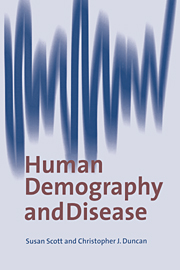Book contents
- Frontmatter
- Contents
- Preface
- Conversion table for imperial to metric units
- 1 Introduction
- 2 Tools for demography and epidemiology
- 3 Identification of population oscillations: a case study
- 4 Density-dependent control and feedback
- 5 Modelling the endogenous oscillations and predictions from timeseries analysis
- 6 Cycles in the grain price series
- 7 Interactions of exogenous cycles: a case study
- 8 Mortality crises and the effects of the price of wool
- 9 Modelling epidemics for the demographer: the dynamics of smallpox in London
- 10 Non-linear modelling of the 2-yearly epidemics of smallpox: the genesis of chaos?
- 11 Measles and whooping cough in London
- 12 Integration of the dynamics of infectious diseases with the demography of London
- 13 Smallpox in rural towns in England in the 17th and 18th centuries
- 14 Infectious diseases in England and Wales in the 19th century
- 15 Prospectives – towards a metapopulation study
- References
- Index
12 - Integration of the dynamics of infectious diseases with the demography of London
Published online by Cambridge University Press: 25 January 2010
- Frontmatter
- Contents
- Preface
- Conversion table for imperial to metric units
- 1 Introduction
- 2 Tools for demography and epidemiology
- 3 Identification of population oscillations: a case study
- 4 Density-dependent control and feedback
- 5 Modelling the endogenous oscillations and predictions from timeseries analysis
- 6 Cycles in the grain price series
- 7 Interactions of exogenous cycles: a case study
- 8 Mortality crises and the effects of the price of wool
- 9 Modelling epidemics for the demographer: the dynamics of smallpox in London
- 10 Non-linear modelling of the 2-yearly epidemics of smallpox: the genesis of chaos?
- 11 Measles and whooping cough in London
- 12 Integration of the dynamics of infectious diseases with the demography of London
- 13 Smallpox in rural towns in England in the 17th and 18th centuries
- 14 Infectious diseases in England and Wales in the 19th century
- 15 Prospectives – towards a metapopulation study
- References
- Index
Summary
The results of a time-series analysis of smallpox mortality in London are given in Chapter 9 and are shown in Chapter 10 to be consistent with linearised and non-linear models in which the epidemics are driven by an oscillation in susceptibility (δβ) produced by seasonal climatic conditions when the frequency of this is at, or close to, ωr. These mathematical models are, necessarily, simplified and are not integrated into the population dynamics. An extended model of a driven system is introduced in this chapter; it includes the mortality from smallpox, the rate of vaccination and changes in population size. These are potentially important factors where the disease is lethal and a substantial proportion of those infected die or where the population is increasing steadily (as in London in the 18th century). The objectives of this modelling of the smallpox epidemics in London are:
(1) To test the robustness of the model when these additional parameters are included and to confirm, in particular, that the system can be driven by an oscillation in δβ.
(2) To simulate the pattern and detailed characteristics of the smallpox epidemics in London and so verify the model.
(3) To study the effect of varying the parameters, for example δβ or the proportion of the infectives dying, on the behaviour of the model. From such studies it is possible to predict some details of the epidemiology and biology of the disease in London in the 18th century, before the major impact of inoculation and vaccination.
[…]
- Type
- Chapter
- Information
- Human Demography and Disease , pp. 244 - 269Publisher: Cambridge University PressPrint publication year: 1998



